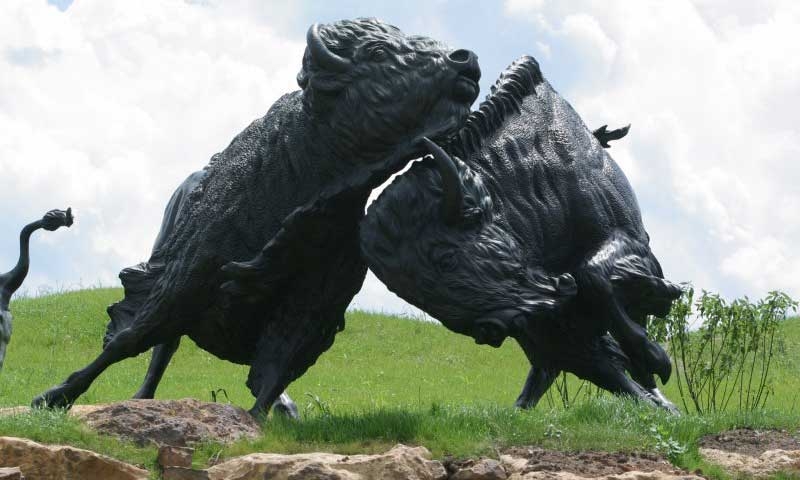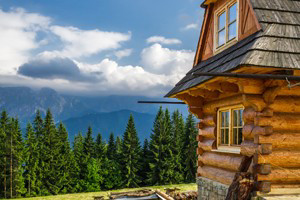Black Hills South Dakota Museums & History
Black Hills history is rich and complex, stretching from pre-historic times when dinosaurs roamed the area, to ownership by the French, Sioux tribe domination, gold-mining, turbulent wars and western expansion.
Visit a Museum or Historic Site
- 1880 Central Railroad: This 2 hour journey will take you back in time on the historic line between Keystone and Hill City.
- Chapel in the Hill: This beautiful chapel has the look of a Norway church and is well work the visit.
- Wild Bill Hickok's Grave: Learn about stories from a time now past with a visit to the Mount Moriah Cemetery in Deadwood.
- Black Hills Gold Mines: Step back in time and tour one of the area's many gold mines. You might even be able to pan for gold.
- Adams House and Museum: For a taste of life in a day gone-by, take the family to the Adams House and Museum.
- Historic National Fish Hatchery: Great for all ages.
- Mammoth Site of Hot Springs: If the kids love dinosaurs or geology, a visit to the Mammoth Site of Hot Springs will leave you satisfied.
- South Dakota Air and Space Museum: Not something you get to see everyday, explore the inner workings of planes and spaceships.
- Sturgis Motorcycle Museum: Learn what all the hype is when thousands of bikers come to town in August for the annual Sturgis Rally.
- Tatanka: Story of the Bison: An amazing account of the near-extinction of the amazing beasts of the plains.
History of the Black Hills
- The Black Hills of South Dakota features a turbulent history of discovery with episodes of frontier uncertainty and territorial wars.
- Monuments such as Crazy Horse Memorial and Mt. Rushmore serve to commemorate the area’s culture and heritage.
- Influential historical figures include Crazy Horse, Sitting Bull, George Custer, and Gutzon Borglum.
Pre-history of the Black Hills
Geology
- Present-day Black Hills landscapes were formed during the Tertiary Period, when volcanic activity created mountainous domes. Most area rock formations have a 1.8 billion year-old granite core. Sedimentary rocks such as sandstone and siltstones are also located here while Jewel Cave Monument and Wind Cave National Park are comprised of limestone.
Dinosaurs
- Many dinosaur fossils have been unearthed in South Dakota, including The Morrison Formation, located on the Black Hills' outer rim. Pre-historic creatures roamed here during the late Jurassic period, about 150 million years ago. Specimens found in The Morrison Formation include the Brontosaurus.
Prior to 1700
- Archeological evidence suggests Native American tribes were settled in the area as early as 9,000 years ago; artifacts include tools and graves.
- By 1500, A.D, the Arikara (Ree) Indians were settled in the Black Hills and other tribes (Pawnee, Cheyenne, Kiowa, Crow) soon followed.
- 1682 - France claims present-day South Dakota as part of their Louisiana Territory.
1700s
- 1743 - French fur traders and explorers travel the Missouri River and “discover” the area, perhaps the first white people to set foot in the Black Hills.
- 1794 - The Sioux have become the most dominant regional tribe. Their culture centers around the Great Plains bison herds.
1800s
- 1803 – The US acquires the Black Hills as part of the Louisiana Purchase, doubling the country’s size overnight. At a total purchase price of $15 million, per acreage cost is less than 3 cents.
- 1804 – Lewis and Clark further explore the region as part of their expedition.
- 1858 – European settlers begin homesteading in South Dakota. This leads to tensions with the Native American tribes; battles between the groups ensue.
- 1868 – Portions of the Dakota Territory, including the Black Hills, are designated as Indian Reservation by the Treaty of Fort Laramie.
- 1874 -1876 – General George Custer discovers gold and settlers soon flock to the Black Hills in search of their fortune, establishing towns, outposts and ranches.
- 1889 – South Dakota becomes the 40th state of the US.
- 1890 – Wounded Knee Massacre takes place between the US army and the Sioux, ending the Indian Wars. 150 Lakota men, women and children are killed in the massacre.
1900s
- 1906 – Railroads reach the Black Hills. This sparks further growth of towns, agriculture, and other industry.
- 1927 – The sculptor, Gutzon Borglum, begins carving Mt. Rushmore.
- 1940’s – The New Deal provides jobs in the Black Hills forests.
- 1941 – Mt. Rushmore National Memorial is completed.
- 1948 – Sculptor, Korczak Ziolkowski, begins work on Crazy Horse Memorial after being approached by Lakota Chief Henry Standing Bear. When complete, the monument will be 641 feet wide and 563 feet tall.
Present Day
Each year, millions of people visit the Black Hills’ National Parks and Monuments, explore its wilderness, learn about its history and culture, and enjoy one of many recreational activities.





